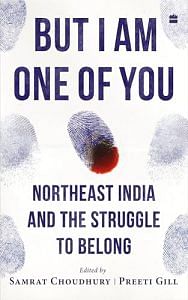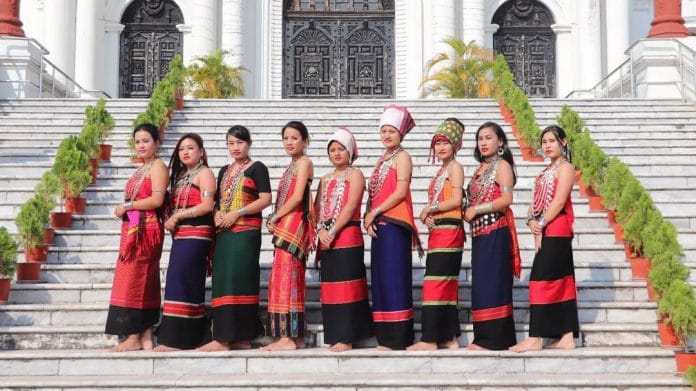It’s the 1980s. A ‘housewife’ with a sewing machine is a powerful entity. Between cooking and laundry, entertaining guests and supervising children’s homework, she seizes moments of solitude to make something of the fabric purchased from months of savings. Under her watchful eyes and nimble fingers, the cloth transforms into blouses, tops and dupattas. These women brought a new word into their households: ‘zari’. It referred to the slim embroidered strips of fabric that they bought in rolls from the market. These were sewn onto the arms of the blouses and the borders of the dupattas, which they later matched with the handmade rignai (traditional wrap-around skirt known as mekhla in Assam and gale in Nagaland). The dupatta was gracefully draped around the body like a half-saree when stepping out of homes. The zari came in a rainbow of colours and added bling to the outfits.
At political gatherings, where women participated in large numbers, this ’80s’ fashion caught up and spread to rural areas. Increasingly, women began to pair the rignai with the dupatta. Alongside slogans for indigenous resurgence, women shared notes on the latest designs and fabrics. The new outfits were a political statement. Tribal women who were earlier mocked as backward and uncivilized were seizing back control of their narratives by dressing as respectable women who stitched together the past and the future with their sewing machines.
Traditionally, tribal women used to pair the rignai with a risha, a long strip of woven cloth, a foot in width, that was used to cover the upper body. It left the neck, shoulders and abdomen exposed and showed off the jewellery—layered coin necklace, broad armband and metal waistband—that glittered and jangled as they moved. As modern colonial conceptions about womanhood made inroads in rural Tripura, women began to change their sartorial choices by covering up in public. During my grandmother’s time, it meant donning a cotton collared shirt while visiting the village market where the traders were mostly non-tribals. As soon as she returned from the trip, she would remove the shirt and wrap a risha instead.
In my mother’s generation, the cotton shirts of my grandmother were replaced by cotton blouses and matching dupattas. As tribal families began to migrate to Tripura’s capital city, Agartala, women began mimicking the ways of the urban space that believed that respectable women must cover up. Hindu tribal women additionally started wearing sindoor, bindi and bangles known as shakha pola (typically worn by married women in Bengal) and started replacing the traditional heavy jewellery with slim gold or silver chains. On the one hand, they saw migrants coming into Tripura as outsiders; on the other, tribal women were imbricating the cuisine, jewellery and womanhood of the former. Simultaneously, many non-tribal families found new favourites in pork, fermented fish and rice wine.
Also read: How a journalist discovered the middlemen making millions off Chhattisgarh Maoist-State conflict
Recalling those days in the ’80s, my mother says that the indigenous women’s movement of the time brought back dignity to their culture by amalgamating the local rignai with the modern blouse. ‘Before we moved to the city and began wearing it to markets and rallies, the urban population looked down upon us. Tribal women, to appear respectable, would wear saris in Agartala. I remember that when I used to go to the markets wearing rignai, the crowd used to stare at me. The women’s movement changed that perception.’ Tribal women had found a middle path as the Bengali ‘bhadralok’ culture found its new domain on their bodies. Additionally, the spread of Christianity among tribals created a simultaneous movement for asserting indigenous identity. Christian women not only ditched the saree but also the sindoor and bangles.
I grew up in the early ’90s, watching two indigenous women leaders navigate between fashion, kitchen and public life. The first was my mother Pabitra Rani Jamatia and the second was Kripa Rani Debbarma. They, along with a dozen other executive members, operated the Tripura Sundari Nari Bahini (TSNB)—the first tribal women’s organization in Tripura that served as both a platform for women’s rights and as a feeder for the larger regional party, Tripura Upajati Juba Samity (TUJS). My father, Nagendra Jamatia, was a leader of the TUJS and became an elected member of the Tripura legislative assembly, while my mother was the general secretary of TSNB. Her duties involved formulating meetings, writing press releases, travelling to remote villages and giving speeches at public rallies.
Kripa Rani Debbarma, my mother’s senior, was the President of the organization and the first indigenous woman to contest in the general elections in 1983, although she didn’t win the seat. I first met her in 1993 when my family shifted to her government residential quarters at Melar Math in Agartala. The quarter was allotted to her husband Harinath Debbarma who was at the time the chief executive member of the Tripura Tribal Areas Autonomous District Council (TTAADC). Yong chwla (older uncle) and Yong Bwrwi (older aunt), as I used to call them, let us use two of the rooms as we didn’t have enough money to rent a house of our own. We lived with them for six months.
I was around eight years old at the time and I watched the two women working closely to organize political rallies and conventions. Their political talks made little sense to a young, impressionable girl.
 This excerpt by Hamari Jamatia from ‘But I Am One of You’, edited by Samrat Choudhury and Preeti Gill, has been published with permission from HarperCollins India.
This excerpt by Hamari Jamatia from ‘But I Am One of You’, edited by Samrat Choudhury and Preeti Gill, has been published with permission from HarperCollins India.







No Bengali only triprasa why uploaded like this this is wrong
No bengali onli tripurasa women tribal culture
No bengali culture bengali culture onli chari
This is not sari at all, and what it means tribal woman wore sari to look respectable? do some research to publish accurate news